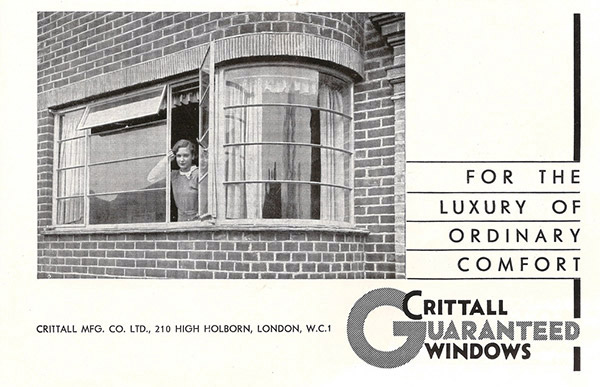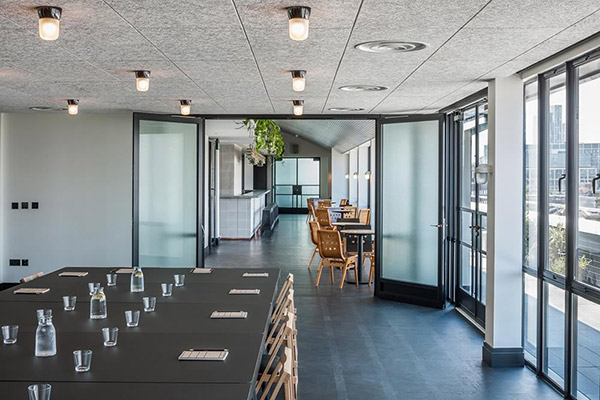We look at the use of metal frames for windows and doors from the early Crittall products up to their use in modern design.
The birth of metal-framed windows
Metal-framed windows were an idea developed as an alternative to wooden frames which require comparatively frequent maintenance. Metal was also chosen for its strength, due to the inherent, unique properties of iron – both for load-bearing and resistance to the elements. Over the years, the technology used in the manufacturing process has been refined and applied to modern-day designs: for architectural doors, walls and internal screening.
The dominant manufacturer was Crittal. In 1860, Francis Henry Crittal was born into a family located in Braintree, Essex that owned an ironmongery business. In 1884, the first-ever windows were made by F.H. Crittal and the business began to thrive. Crittal was trademarked and continued to expand into manufacturing in the US, China and Europe.
The 1930’s and 40’s saw boom-time production of metal windows associated with both the Art Deco and Modernist movements. Architects and builders of the time specified them as both fashionable and practical for their era of Design style. A notable feature was the use of curved windows and glass panels for corners of buildings, curves being synonymous with Art Deco design. The advantage was that with metal the shapes could be formed in the factory and simply fitted to a built structure, often with the glazing already in.

Original advert for Crittall windows from 1935
1977 saw the first polyester powder coating applied to galvanised steel windows which allowed the application of colours and coatings to the frames, thus expanding their scope of use into door frames, frameworks for buildings, such as conservatories, and contemporary glass structures.
Typically used, and perhaps most recognisable as ‘factory windows’ with mills and factories in the north of England during the 19th century they thrived during the Industrial Revolution. They also became synonymous with ‘working class’ culture. As British manufacturing started to decline, factory and warehouse buildings became redundant. Consequently, private owners sought to develop and restore these magnificent open-plan buildings, with their large, metal “statement” windows, into desirable homes such as luxury flats, warehouse-flats and ‘city lofts’.
The main advantage of these metal windows was their size, with individual, multiple panes of glass able to open independently of each other. This allowed them to let in maximum light whilst looking robust and exuding strength through their bold, clean lines.
Designers saw the beauty in this and began, in the 1980’s and 90’s, to specify metal frameworks for not just windows but entire walls -often those in a contemporary glass extension where a slim profile was required with sufficient strength to support heavy pieces of glass. It allowed larger expanses of glass to be used and, as metal components developed, sliding frames for doors and windows became ever slicker. In fact, they became an architects’ favourite for ground- floor extensions leading onto gardens, where a whole elevation can be slid open to “bring the outside inside”. Superior thermal efficiency is also a huge plus to installing aluminium bi-fold doors. Weather-tight and air-tight seals can be achieved with insulating strips inserted into the metal frame cavities and suction locking mechanisms ensure they are draught-proof.
Interior designers also acknowledge the beauty in the slim but strong profile of metal frames and now specify them for interior screens and room dividers. They are now even being used in bathrooms for retro- styling for shower enclosures – the glass dividing-wall deployment, once again. Stylists even use vintage factory windows, bought at antique fairs and from specialist dealers, whose mirror panels have replaced the original glass, making them into striking, wall-hung decorative mirrors.
One recent project showcasing the most technically-refined Crittal window system, the W20 range, is the ACE Hotel in Shoreditch. Supplied by Crittal, which worked to a contemporary brief and architects’ specification, the windows and doors look almost timeless. The project is located just minutes from the conservation area of Brick Lane, where grain warehouses and factories used to house skilled trades – from silk weaving to ship-building. These buildings still have their original metal-window frames intact, so the refashioning of the ACE Hotel with its own steel-framed fenestration, references the heritage of Crittal windows, yet articulates a new and popular design trend.

Crittall windows from the W20 range installed in the ACE hotel, Shoreditch, London designed by Universal Design Studio
When protective coatings are neglected, however, corrosion may occur in the form of rust and split masonry where a frame has become warped out of shape. However, if properly maintained, metal frames can last for centuries. This is their huge advantage.